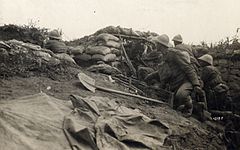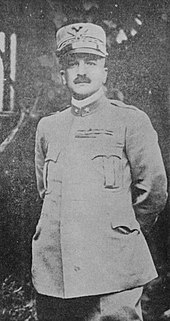Second Battle of the Piave River
| Battle of the Piave River | |||||||
|---|---|---|---|---|---|---|---|
| Part of the Italian Front (World War I) | |||||||
 Map of the Second Battle of the Piave River | |||||||
| |||||||
| Belligerents | |||||||
|
|
| ||||||
| Commanders and leaders | |||||||
| Strength | |||||||
|
57 divisions:[1] 5,650 guns1,570 mortars 676 aircraft |
58 divisions:[1] 6,833 artillery pieces | ||||||
| Casualties and losses | |||||||
|
87,181:[2] 8,396 dead 30,603 wounded 48,182 captured |
118,042:[2] 11,643 dead 80,852 wounded 25,547 captured | ||||||
The Second Battle of the Piave River (or Battle of the Solstice), fought between 15 and 23 June 1918, was a decisive victory[3][4] for the Italian Army against the Austro-Hungarian Empire during World War I, as Italy was part of the Allied Forces, while Austria-Hungary was part of the Central Powers. Though the battle proved to be a decisive blow to the Austro-Hungarian Empire and by extension the Central Powers, its full significance was not initially appreciated in Italy. Yet Erich Ludendorff, on hearing the news, is reported to have said he 'had the sensation of defeat for the first time'.[5] It would later become clear that the battle was in fact the beginning of the end of the Austro-Hungarian Empire.[6]
Background
With the
Prelude
Italy's defeat at Caporetto led to General

The Austro-Hungarian Army had also recently undergone a change in command, and the new Austro-Hungarian Chief of Staff,
The Austro-Hungarians, differently from their previous success at
Battle
General Diaz learned the exact timing of the Austro-Hungarian attack: 3:00 a.m. on 15 June, so at 2:30 a.m., the Italian artillery opened fire all along their front on the crowded enemy trenches, inflicting heavy casualties. In some sectors the
Thick bursts all around me, very close. I saw many who died and who were wounded. I will never forget those two days. A young soldier fell wounded; a piece of shrapnel had entered his right leg, another under the right eye and another in the right ear...[9]
On the subsequent days Boroević renewed the assault, but the artillery barrage destroyed many of the river's bridges; the Austro-Hungarian formations that had crossed the river were unable to receive reinforcement and supplies. To make matters worse, the swollen Piave isolated a great number of units on the west bank of the river, which made them an easy target for the Italian fire. It was reported that a large number of Austro-Hungarian soldiers drowned while trying to reach the east bank.[10] On 19 June, Diaz counterattacked and hit Boroević in the flank, inflicting heavy casualties.
In the meantime Conrad attacked along the Italian lines west of Boroević on the Asiago Plateau (on 15 June), with the objective of capturing Vicenza. His forces gained some ground, but came upon stiff resistance from Italian units;[8] 40,000 casualties were added to the Austro-Hungarian total. In the aftermath, Boroević was particularly critical of the behavior of Conrad who, after the complete failure of the first attack, preferred to continue the assaults in the subsequent days but with diminished strength, rather than send reinforcements to the Piave sector.[8]
Lacking supplies and facing attacks by armored units, the Austro-Hungarians were ordered to retreat by Emperor Karl, who had taken personal command, on 20 June.[8] By 23 June, the Italians recaptured all lost territory on the southern bank of the Piave and the battle was over.
Aftermath

After the Austro-Hungarian retreat Diaz was pressed by the allies, particularly by General Ferdinand Foch, to press on and try an assault to break the Austro-Hungarian defences and gain a decisive victory over the Empire. However, the Italian General recognized that the same tactic, that proved so effective on defence, prevented an immediate offence, as the Italian formations at that time were too scattered and mixed up to be effectively coordinated in a decisive assault. Moreover, once the Italian Army crossed the river, they would have to face the same logistic problems as the Austrians. For these reasons, in the subsequent days, only limited actions were fought to gain better start positions for the decisive assault.
On the other side, the Battle of the Piave River was the last great military offensive of Austria-Hungary. A clear failure, the operation struck a major blow to the army's morale and cohesion and had political repercussions throughout war-weary Austria-Hungary.[11] The battle signaled the beginning of the end of the imperial-royal army as an effective fighting force and foretold the internal political collapse of the multi-ethnic Austro-Hungarian Empire, which was finished off at the Battle of Vittorio Veneto four months later.[12][13] The army offered stiff resistance for four days from 24 to 28 October during the Allied offensive but collapsed as word reached the troops of the Empire's disintegration at which point there was little point to continue resisting.
The battle also dealt a severe blow to the German Empire strategy, who considered a separate peace with Italy (and exploiting Italian resources in the affluent Po Valley) as a viable way to concentrate efforts in the western front to finally overcome the Allied forces. Erich Ludendorff wrote:[14]
This unsuccessful attack was extremely painful. I could no longer hope that relief on the Western Front might be secured in Italy itself.
Order of battle

Italy (Armando Diaz) (west to east)
- 7th Italian Army (Giulio Cesare Tassoni)
- 1st Italian Army (Guglielmo Pecori Giraldi)
- 6th Italian Army (Luca Montuori)
- 4th Italian Army (Gaetano Giardino)
- 8th Italian Army (Enrico Caviglia)
- Duke of Aosta)
- 9th Italian Army (Paolo Morrone) : in reserve.
Austria-Hungary (Arthur Arz von Straußenburg) (west to east)
- Army Group Conrad (or Armygroup Tirol) (Franz Conrad von Hötzendorf)
- 10th Army (Alexander von Krobatin)
- 11th Army (Viktor Graf von Scheuchenstuel)
- Army Group Boroević (Svetozar Boroević)
- 6th Army (Archduke Joseph of Austria)
- Wenzel Freiherr von Wurm)
In popular culture
- Today, to the Italian public two mottos recall the battle: those written as graffiti upon broken walls of destroyed rural houses: "E' meglio vivere un giorno da leone che cent'anni da pecora" ("[It] is better to live one single day as a lion than a hundred years as a sheep") and "Tutti eroi! O il Piave o tutti accoppati" ("Everyone a hero! Either (we hold) the Piave, or let all of us get killed"). The two pieces of wall are preserved in the military shrine of Fagarè della Battaglia, a frazione of San Biagio di Callalta.
- The Battle is also known as the "Battle of the Solstice" so-called by the poet Gabriele D'Annunzio, shortly thereafter. On 9 August 1918, D'Annunzio conducted his Flight over Vienna with 11 Ansaldo airplanes throwing thousands of leaflets from the sky, praising the Italian victory.
- In the shelling and firefights that occurred in July and August after the battle, an 18-year-old American ambulance driver named Ernest Hemingway was wounded there on July 8. Hemingway was knocked unconscious during an Austrian mortar attack. Fragments of the shell entered his lower extremities. Two Italian soldiers standing with Hemingway were killed. In the 1932 film adaptation of Hemingway’s novel A Farewell to Arms, Frederic Henry (Gary Cooper) is wounded in the leg at this Battle.
- The battle is described in Andrew Krivak's novel, "The Sojourn".
- The battle is mentioned in the André Aciman's novel and film Call Me by Your Name. The scene in the film takes place overlooking a memorial to the victims of the battle. The memorial is located in the city of Pandino. In the film however, it is said that 170,000 people died in that battle of Piave.
- Pope Francis mentioned in June 2022, in an interview with Jesuit European cultural journal editors, that one of his two grandfathers participated in "an experience on the Piave River", during World War I, presumably referring to either the first or second Piave River Battle.[15]
- The map "Piave" will be featured on FPS-tactical shooter Isonzo (video game), coming February 28th.[citation needed]
See also
- First Battle of the Piave River
- "La Leggenda del Piave", a patriotic song written by E. A. Mario after the battle.
- Pietro Micheletti, Italian military commander fighting in the battle
- Attilio Deffenu, Italian journalist and soldier who died in the battle
Citations
- ^ a b Clodfelter 2017, p. 419.
- ^ a b Tucker, Spencer. "World War I: Encyclopedia, Volume 1". Page 919.
- ISBN 978-0850529791.
- ^ "First World War.com - Primary Documents - G.M. Trevelyan on the Battle of the Piave River, 15-22 June 1918". www.firstworldwar.com. Retrieved 4 July 2017.
- ISBN 0-416-18940-7
- ^ Fuller, John Frederick Charles: Decisive battles: Their influence upon history and civilization. C. Scribner's sons, 1940, p 912
- ^ Rothenburg, G. The Army of Francis Joseph. West Lafayette: Purdue University Press, 1976. p 212.
- ^ a b c d e f Rothenburg 1976, p. 213
- ^ "Letter from Harukichi Shimoi". 26 September 2023.
- ^ Halsey, Francis Whiting: The Literary Digest History of the World War: Compiled from Original and Contemporary Sources. Funk & Wagnalls Company, 1919, V.9, p 143
- ^ Rothenburg 1976, p 213–214
- ^ "The comprehensive failure of the offensive served merely to hasten the disintegration of the Austro-Hungarian army. Its destruction was completed by the Italians at the Battle of Vittorio Veneto in the autumn." The Battle of the Piave River, 1918
- ^ Simonds, Frank Herbert: History of the World War, Volume 5. Doubleday, 1920, p 359
- ^ Ludendorff, General. My War Memories Vol.2. p. 635.
- ^ "Pope Francis in Conversation with the Editors of European Jesuit Journals". 14 June 2022.
References
- Clodfelter, M. (2017). Warfare and Armed Conflicts: A Statistical Encyclopedia of Casualty and Other Figures, 1492-2015 (4th ed.). Jefferson, North Carolina: McFarland. ISBN 978-0786474707.
- Tucker, Spencer The Great War: 1914–18 (1998)
- The Battle of the Piave River, 1918
- Cronologia: il "Secolo Breve" dal 1914 al 2000 (in Italian)
